Advancing Knowledge
Advancing Scientific Knowledge on Tipping Points and Common Pool Resources
MultiTip conducted an analysis of the Lake Victoria resource system with the goal of contributing to knowledge on tipping points and on common pool resource management.

To achieve a holistic view of the socio-ecological system, we use an interdisciplinary approach. Our experts use mathematical modelling and insights from environmental economics to understand the resource system and interactions with it. We also analyse the system's stakeholders using methods from both psychology and behavioural economics.
|
Understanding the Resource System |
|
|
|
|
|
|
|
|
Understanding Interactions |
|
|
|
|
|
|
|
|
|
|
|
Understanding Stakeholders |
|
|
|
|
|
|
Risk Taking Behaviour Among Fishers: Social Information and Luck |
|
|
|
|
|
Back to Achievements Summary
A Tipping Point Concept for Lake Victoria
Tipping points are an important property of many complex SESs like the Lake Victoria Nile perch fishery. Understanding the occurrence of tipping points in both experimental and empirical settings is important for the sustainable management of an SES.
To this end, we developed a mathematically rigorous, general, analytical and operationalized tipping point concept for the Lake Victoria resource system. We call this concept the subcritical bifurcation of system dynamics. It is applied to the single-species Nile perch context, which constitutes a first capstone of the project.Behind this deliverable stands an important shift that MultiTip has set into motion in modeling the Lake Victoria resource system: moving from computational box models with merely computed trajectories to more analytical approaches that emphasize system characteristics like stable equilibria, regime shifts and tipping points.The subcritical bifurcation of system dynamics can be used to identify tipping points in corresponding mathematical models. It also enables an understanding of which non-linear components of the model cause the phenomenon and which types of feedback should be examined. Thus, it is used to improve the understanding of the SES and of the corresponding decision-making processes.
Researchers: Johannes Kammerer (Ph.D. Candidate), Prof. Dr. Anna Marciniak-Czochra, Prof. Timo Goeschl, Ph.D.,
Publication: Marciniak-Czochra, A. (2021). Mathematical models for tipping points. In: Boutrus, M., Nussel, F. (eds.): Forum Marsilius Kolleg 19, 139-143. doi:10.11588/fmk.2021.0.78677
Top of page
Spatiality of the Resource System
Over-exploitation of the Nile perch fishery, coupled with difficulties in fisheries management, should result in depletion of the fish stock and consequently, a fall in productivity. However, the fishery has maintained a consistent overall productivity over the last decade (Kolding et al., 2014). There is no consensus on the reasons for this relative stability. For a better understanding of the resource system, MultiTip examines the effect of the spatiality of the system on the ability of fishers to exploit the resource (Gómez-Cardona, 2022). We find that the Lake's spatial dimensions (both size and shape) have surprising socio-ecological consequences.
Our spatial model shows that Lake Victoria's sheer size, combined with its shallowness, creates fish habitats that are distant from the shore (some more than 70km). This is because artisanal fishing there is economically unprofitable given fishing technology, fuel cost, and fish prices (Gómez-Cardona, 2022). Therefore, our model expats the spatial pattern the fleet fishing, i.e. why most boats fish close to the shore, despite the localised competition for fish (Peter van Zweiten, 2018). This pattern has created de-facto protected habitats with low or no fishing effort taking place on them. These areas can act as potential reserves and increase the resilience of the resource system to both continued harvesting pressure and external shocks (Gómez-Cardona, 2022). Nevertheless, technological changes and increases in fish prices can affect this balance and bring the system to a lower stability level.
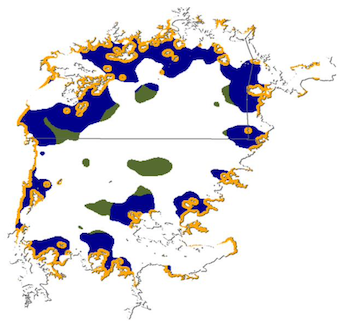
Fishing effort is divided into three boat categories: yellow for paddle boats, blue for motor boats and green for motor boats that make multiple-day fishing trips. The figure shows that fishing is mostly concentrated near the shore. Large areas of the lake are not exploited.
Researcher: Dr. Santiago Gomez-Cardona
Publication: Gómez-Cardona, S., 2022, Spatial Structure effects on Fisheries Management for Lake Victoria's Nile Perch. AWI Discussion Paper 713, Heidelberg University. https://doi.org/10.11588/heidok.00031342
Data-Model Integration in Fisheries Research
A common approach of studying lake management in agent-based models is to treat social processors and decision-making about resource use as external factors (Martin & Schülter, 2015). However, to improve management, it is crucial to recognize the dynamics in a coupled SES. This requires methods to account for how humans are shaping and shaped by the ecosystem they interact with (Folke, 2006).
MultiTip has succeeded in this critical task by integrating socio-ecological survey data with new analytical models of the resource system. This was done using the spectrum slope of the fish size distribution as a management-relevant integration point. We were able to adjudicate between conflicting survey evidence by using the model to structure the four sets of survey data (Catch Assessment Survey, Frame Survey, Hydro-acoustic Survey, Bottom-Trawl Survey). Moreover, this data was used to calibrate the analytical model for the Nile perch with optimization and Bayesian inference (Edwards et al., 2017; Miles, 2019).
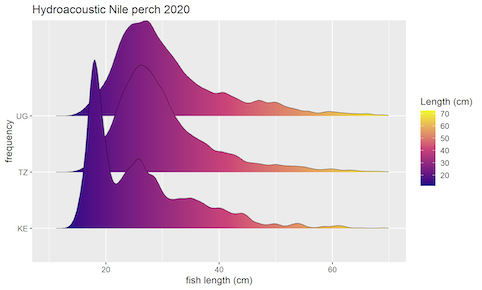
Empirical size distribution of the Nile perch population in Uganda, Tanzania and Kenya from the Hydro-acoustic Survey, 2020
This constitutes a breakthrough in the analysis and interpretation of size-based fish population data at Lake Victoria and its rigorous integration into a state-of-the-art numerical stock model. We also identified the spectrum slope as a key management indicator of population health and reproductive potential (Blanchard et al., 2014; Diekert et al., 2010) which is critical for system stability. From the spectrum slope, we then simulated how fishing selectively translates to catches.
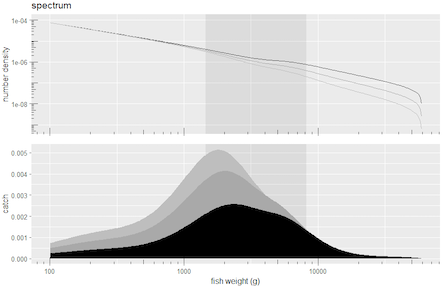
Simulation of the fishery with the empirical fleet selectivity and the effect of the fishing pressure on the size distribution of the fish stock (top) and on the size distribution of the catch (bottom). Gray shaded rectangles indicate the range of legal fishing size (50-85cm). With higher fishing pressure (increasing from black to gray) the spectrum slope becomes more negative (top) and the catch distribution shifts towards smaller fish (bottom).
Researchers: Johannes Kammerer (Ph.D. Candidate), Prof. Timo Goeschl, Ph.D. , Prof Dr Anna Marciniak-Czochra
Partners: Dr. Robert Jeremiah Kayanda (LVFO) , Dr. Chrisphine Nyamweya (KMFRI)
Impact of Gear Regulations on Stock Resilience
Policy-makers in Uganda, Kenya, and Tanzania have recognized the importance of protecting the juvenile fish stock for some time. The result is regulations on legal catch size (50 – 84 cm), minimum legal longline hook sizes and minimum gillnets mesh sizes in the Nile perch fishery (LVFO, 2016). There is an open discussion about the specific merits of using enforcement to achieve compliance (Cepić and Nunan, 2017; Obiero et al., 2015). Although this is extremely important, it should be complemented with an analysis on the effectiveness of these regulations in achieving the desired affect on the fishery. MultiTip has been generating novel insights on how these gear regulations impact on the resource system.
We examine the impact of gear selectivity of gillnets and longline hooks on the resilience of the Nile perch population. We use a decade data on catch (Catch Assessment Survey, 2010 - 2020) and our analysis provides evidence that a gill net fishing fleet is capturing increasingly larger fish and this trend correlates with increased enforcement of the mesh size regulation (Gómez-Cardona, Kammerer and Mrosso, 2022). The hook fishing fleet, by contrast, is not experiencing any changes in the sizes they are targeting and the sizes of the fish that are captured (idem) despite an increasing use of smaller hooks (Aloo et al, 2017). Overall, the evidence suggests that gill-net mesh size regulation is effective in protecting juvenile fish stock while the hook size regulation appears to miss its intended effect
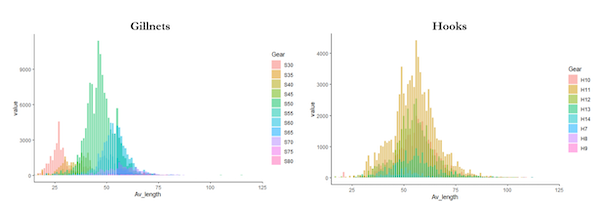
Catch size distribution from different sizes of Gillnets (left) and Hooks (right). The y axis refers to the total amount of individuals in the sample used to generate the graphs. Note: there is a change in the catch sizes capture as the gillnet size increase but this is not the case on hooks, for which the range of captures sizes do not change with sizes. Source: Gómez-Cardona et al., 2022
Researchers:Dr. Santiago Gomez-Cardona, Johannes Kammerer (Ph.D. Candidate), Prof. Timo Goeschl, Ph.D., Prof. Dr. Anna Marciniak-Czochra
Partner: Hillary Mrosso (TAFIRI)
Publication: Gómez-Cardona, S.; Kammerer, J. and Mrosso, H. 2022. Fishing Fleet Selectivity in Lake Victoria. AWI Discussion Paper 712, Heidelberg University.
Modelling Size-Selectivity
Size structure of the fish stock describes the relative frequency of fish sizes in the population. It plays a significant role in the assessment of a fish stock and the sustainability of a fishery because fish age and size are tightly coupled - even so far that a population can be described equivalently by the age or the size structure. Only fish of a certain size are mature and can reproduce which means that size structure plays a crucial role for the reproductive capacity of the population.
Every fishery needs to optimise the trade-off between maintaining stock reproductive capacity (conserving large fish) and allowing the juveniles to reach the reproductive state (conserving young fish) (Diekert, 2012). In Lake Victoria, a slot size regulation of 50 to 85cm was introduced to protect immature fish, harvest mature individuals and at the same time protect the larger females (Njiru et al., 2019). The investigation of the selectivity of the gear types used in the Nile perch fishery provides the possibility to simulate the effect of fishing policies. While policymakers often know the ideal outcome, they have few tools to forecast the effect of gear type restrictions on the stock. We created a model which provides a quantitative basis for policymakers to better understand this trade-off. Finding the maximum sustainable yield (MSY) in the simulation points to the optimal use and which combination of gear types can be used to catch fish of a high value while maintaining the capacity of the stock to regenerate.
In the model, the fish population is continuously structured in the size variable to adequately incorporate the size-dependent feeding and growth rates. We used the biological model framework of Andersen (2019), where the rates of fish growth and natural mortality are derived from biological scaling laws. Our model has the following assumptions: The relevant entity in the population is the individual fish, which has a bioenergetic budget, and growth, reproduction and non-predation mortality rates follow from it. Fishing is a size-selective process that targets fish in a specific size range and adds to the natural mortality. We assumed the population to be in an equilibrium (steady state) and studied the annual yield for a range of fishing intensity levels. In a first step, the model was validated against empirical data, in a second step the model was simulated under modified fishing intensity and thirdly, the effect of four fleet selectivity scenarios on the equilibrium yield was analyzed.
The model was validated by comparing the simulated growth curve with the well-known van Bertalanffy curve and by comparison to the size structure from three different surveys. Using the empirical fleet selectivity from Gomez, Kammerer, and Mrosso (2022) as an input, the simulations of the size structure of the fish population are similar to the empirical size distribution from the bottom-trawl and the catch assessment survey. The size distribution of the hydroacoustic survey, however, differs both from the bottom-trawl survey and from the model simulation. Because the model and the two other surveys agree in the size structure, we conclude that it is possible that the hydroacoustic survey does not represent the size structure correctly. A potential reason could be the target strength-size relation in the calibration of the hydroacoustic survey, but more research is needed to investigate the cause.
We find that, under the current fleet selectivity, the empirical annual yield (207.59kt) is close to the maximum sustainable yield (207.77kt) (shown in the table below). Correspondingly, also the empirical peak fishing mortality rate, F=1.036/yr, is only 2.0% above the rate that leads to the maximum sustainable yield (F=1.015/yr). The value of MSY is similar to a previous estimate of Kayanda et al. (2009).

In addition to the empirical selectivity of the fishery (“open”) we have simulated three hypothetical fleet selectivity shapes (fishing only >50cm; fishing only <85cm; and strict adherence to the slot size 50-85cm) to predict the effect of the selectivity on the fish stock and the equilibrium yield. For the comparison, each scenario was simulated as the solution of the steady state of the McKendrick-von- Foerster equation across a wide range of fishing levels (see figure below). We find that sparing all fish below 50cm, while keeping the fishing mortality above 50cm the same, increases the annual yield by 17.7% from 207.59kt to 244.30kt. Catching no fish above 85cm, decreases yield by -28.0% from 207.59kt to 149.52kt. The maximum sustainable yield is highest in the scenario where fishing is only above 50cm, and lowest in the scenario where fishing take place only below 85cm.
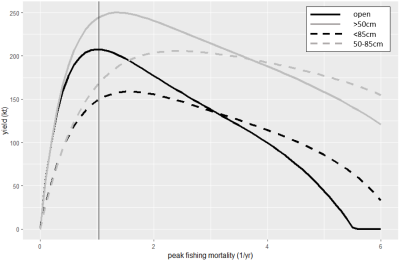
We have tested the sensitivity of the results and have found that the uncertainty in the physiological mortality parameter has the strongest influence. The value of the growth parameter and of the maturation size have less influence on the results. .
One outcome of this model was MultiTip Policy Brief #1. To view the policy brief click here.
Researcher: Johannes Kammerer (Ph.D. Candidate), Dr. Santiago Gomez-Cardona, Prof. Timo Goeschl, Ph.D., Prof. Dr. Anna Marciniak-Czochra
Partner: Dr. Chrisphine Nyamweya (KMFRI)
Publication: Kammerer, J., Gómez-Cardona, S., and Nyamweya, C. (2022). Size selective fishing: The effect of size selectivity on the equilibrium yield in the Nile perch fishery of Lake Victoria. AWI discussion paper series, dp720.
Fishery Regimes and Impact of Gear Choice
The regulation of gears constitutes a fisheries management strategy primarily aimed at preserving immature fish. This approach circumvents the politically sensitive and difficult-to-enforce direct restrictions on entry and catches that characterize many developing contexts. However, existing recommendations often oversimplify socioeconomic dimensions and assume complete government control over gear selection. This oversimplification overlooks crucial effects resulting from the fishers’ agency. To address this gap, our study highlights the implications of fishing gear selection in the outcomes of a fishery (Gómez-Cardona & Kammerer, 2023).
We propose that the choice of fishing gear, i.e., the ability of fishers to select for different fish sizes, has significant direct implications for management due to the distinct fishery regimes it leads to. A swift transition between two states characterizes these regimes: one with high output value and a significant proportion of fishers targeting large fish, and the other with low output value and a predominant number of fishers aiming for small fish. These regimes emerge in response to contextual variables such as prices and economic activity and are not a product of government intervention. Policy management operates on top of these regimes, taking advantage of or hampered by them depending on the context. Our findings are derived from an agent-based model replicating the general conditions on the Nile Perch Fishery in Lake Victoria and accurately simulating its age-structured fish stock. This allows for dynamic shifts driven by gear choices that target different fish sizes.
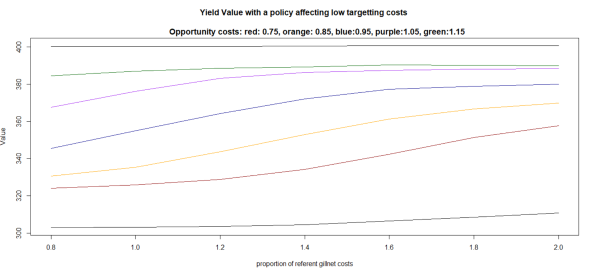
Understanding the resource system requires integrating the dynamics of a size modelled stock with the socioeconomic responses that fishers take as a response to the profitability of the catch. To this end, an agent-based model was built. This model incorporates the dynamics of the ecology of Nile Perch using a cohort base approach that replicates the size structure of the stock. Therefore, it allows us to model fishing with gear that have a particular selectivity profile and to model the decision to choose gear with different profiles. In the model, each agent corresponds to an individual boat that has to make a decision whether to fish and which gear to use. They update the decision constantly as their fishing outcomes change and observe the behaviour of other agents. Individual variation in profits comes from the natural variability on the catch at which every boat is exposed. The model is calibrated using real data on the biological parameters of the stock, gear selectivity, and the outcomes and costs of fishing activities. The structure of the model facilitates incorporating a diverse set of policies that change agents’ decisions. Price subsidies and enforcement activities can be easily incorporated in to the structure of the model and their consequences for fishing management analyzed.
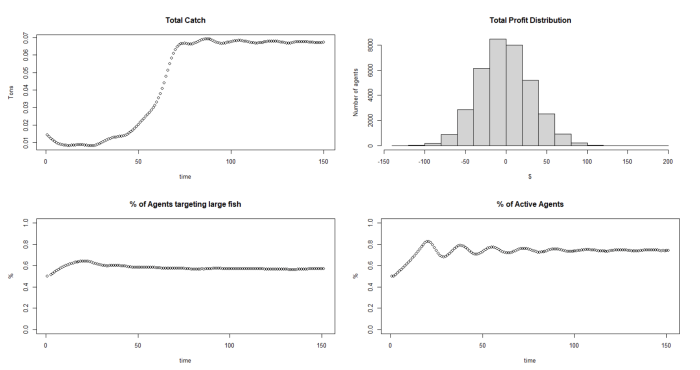
Researchers: Johannes Kammerer (Ph.D. Candidate), Santiago Gomez-Cardona, Grigori Schapoval (Bachelor Student in Computer Science), Hamsa Zazai (Master Student in Economics), Prof. Timo Goeschl, Ph.D., Prof Dr Anna Marciniak-Czochra
Publication: Gómez-Cardona, S. & Kammerer, J. (2023) Impact of Gear Choice on Open Access Fisheries:
A Study on Fishery Regime. AWI Discussion Paper Series No. 732, Heidelberg University. http://www.ub.uni-heidelberg.de/archiv/33772
Compliance Subsidies as Novel Regulatory Instruments
The current governance of Lake Victoria’s resource system relies on a coercive regime favouring direct enforcement (LVFO, 2016). In theory, this would deter illegal gear use as fishers consider the probability of detection and punishment. However, in reality, this method leads to sporadic and harsh enforcement that generates limited deterrence at high cost, destroys assets (boats and gear, some of it legal) and regularly leads to fatalities among both fishers and enforcers (Kolding et al., 2014; Obiero et al., 2015; Cepić and Nunan, 2017).
We used a field intervention to test regulatory alternatives to the current detect-and-burn approach (Diekert et al., 2022). For this experiment, the Dagaa (silver cyprinid) fishery was chosen as it represents a simple fishery in terms of technology and fishing dynamics that facilitated reaching the intervention goals. We held workshops at 20 landing sites in Tanzania in which fishers had the opportunity to buy legal sizes nets using an explicitly designed mechanism for the task: a Multiple Price List Mechanism. Additionally, a verbal nudge that incentivises cooperation was also tested as a procedure to increase the effectiveness of the intervention.
This intervention shows that subsidies on legal gear have the potential to drive out illegal gear at acceptable cost, but also evidence that soft measures that appeal to ‘good fishing practices’ are ineffective. This field experiment provides a first proof-of-principle regarding the feasibility of compliance subsidies on legal fishing gear as a novel tool in fisheries management. Ongoing work is using data on the selectivity of legal and illegal gear to provide an estimate of the damages that can be avoided by increasing the proportion of fishers using legal nets.
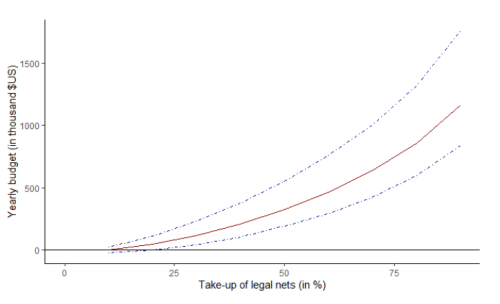
An estimation of annual costs for increasing the take-up of legal size nets, with 95% confidence interval, that is needed to reach different target levels of compliance with net sizes (x-axis: proportion of fishers using legal nets, y-axis: budget that must be allocated in on year to a subsidy program).
Researchers: Prof. Dr. Florian Diekert, Dr. Tillmann Eymess, Prof. Timo Goeschl Ph.D., Dr. Santiago Gómez-Cardona
Partner: Joseph Luomba (TAFIRI)
Publication: Diekert, F., Eymess, T., Goeschl, T., Gómez-Cardona, S. & Luomba, J. (2022) Subsidizing Compliance: A Multi-Unit Price List Mechanism for Legal Fishing Nets at Lake Victoria. AWI Discussion Paper 0711, Heidelberg University. http://nbn-resolving.de/urn/resolver.pl?urn=urn:nbn:de:bsz:16-heidok-313400
Mental Models and the M-Tool
Mental models are internal representations of an external system. They consist of causal beliefs about the how a system functions (Bostrom, 2017) and can be used to provide insights on a system based on stakeholders perceptions and behaviour (Forrester, 1992). Therefore, they are identified as a leverage point within psychology research for addressing sustainability challenges (Goldberg et al., 2020). Diagram drawing methods are commonly used to illicit mental models. The current software developed for this purpose has been successful in producing insights (e.g. Gray et al., 2014; Wood et al., 2017). However, the resulting mental models may be difficult to compare because respondents enter their own system variables. Moreover, these software have not been designed to asses mental models of individuals with low literacy.
One of the key success of MultiTip has been the development of a universal tool for mental model elicitation. The Mental Model Mapping Tool or M-Tool allows participants to express their views and perceptions about causal relationships in their environment with minimal literacy and numeracy requirements (van den Broek et al., 2021a). This is due to the use of video instructions, pictograms and audio descriptions. In this tool, researchers provide participants with a set of system variables to construct their mental model which eases mental model comparability. Once the researcher has constructed the model, they can share the created study with participants via a link on the web-based app or setting it up on a tablet via the application. A CSV file of the data can be downloaded and read by analysis software such as R. The tool also captures the time that participants take to create their mental model which can be informative of the mapping process (LaMere et al., 2020). The web-based application has additional benefits such as allowing researchers to link the data to an external survey and a bar chart drawing task that displays participants views on the relation between two variables, e.g. fluctuation of a resource over time.

Screenshots of M-Tool: (A) practice session on how to create a mental model (B) presentation of the pictograms and (C) the mental model mapping screen
The M-Tool software can be downloaded for free in the App store and Google Play Store and a web-based application can be found on www.m-tool.org. The tool was developed by Heidelberg University, TAFIRI and Lambdaforge as part of the MultiTip project. It has already been downloaded over 1000 times.
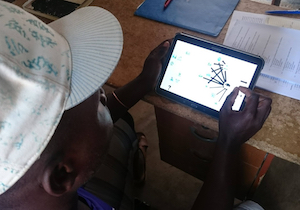
We also tested the M-tool’s application in two field studies with fishers in Tanzania (van den Broek et al., 2021b). We first compared the M-tool to an alternative elicitation technique that is also appropriate for measuring mental models among participants with low literacy: semi-structure, face-to-face interviews (Findlater et al, 2018). Despite similar model composition across the two methods, we found that M-tool mental models were significantly more complex than interview mental models in the total number of drivers that participants used. Second, we related the M-tool models to participants level of education. The higher the participants level of education, the more complex the mental model the participant creates (Levy et al., 2018; Varela et al., 2020). Our study confirmed this and thus, the M-tool is validated in this context. These findings suggest that the M-Tool can successfully capture mental models among diverse participants.
Researchers: Dr. Karlijn van den Broek, Dr. Sina Klein, Dr. Helen Fisher
Partners: Dr. Jan van den Broek, Joseph Luomba (TAFIRI), Lambdaforge
Publications:
van den Broek, K. L., Klein, S. A., Luomba, J., & Fischer, H. (2021a). Introducing M‐Tool: A standardised and inclusive mental model mapping tool. System Dynamics Review, 37(4), 353–362. https://doi.org/10.1002/sdr.1698
van den Broek, K. L., Luomba, J., van den Broek, J., & Fischer, H. (2021b). Evaluating the Application of the Mental Model Mapping Tool (M-Tool). Frontiers in Psychology, 12, 761882. https://doi.org/10.3389/fpsyg.2021.761882
Top of page
Differences in Perceptions Among Stakeholders
Stakeholders’ interactions with environmental resources are strongly influenced by their mental models of the resource. Mental model elicitation can help identify disparities in perceptions between stakeholders. Individual differences in such mental models are particularly important to identify as diverse mental models may be associated with different behaviour or policy preferences and affect collaborative conservation efforts (Rouwette, 2016). During the preparatory phase of MultiTip, we explored the mental models of Nile perch fish stock among stakeholders at Lake Victoria (van den Broek, 2018). The stakeholders consisted of 76 participants from 33 different institutions (including governmental, NGO’s, business organisations, research institutions and community groups) in Uganda, Kenya and Tanzania. This analysis revealed large differences in the perceptions among stakeholders about the state of the Nile perch stocks and drivers of changes to the stock. These differences in perception are important as they may hinder management of the SES. In our following studies, we looked at what may influence these structural differences.
First, we looked at the structural differences in perceptions based on the type of knowledge acquisition, i.e. if the participant received knowledge of the system formally or informally (Klein at al., 2021). We conducted a survey on 225 participants across Tanzania, Uganda and Kenya and found that most participants agreed that the stock has declined. However, participants with informally acquired knowledge focused on examples of fewer drivers related to tangible human activities (e.g., the use of illegal fishing gear), whilst participants with formally acquired knowledge used more abstract and a larger variety of drivers related to the presence of humans (e.g., overpopulation).
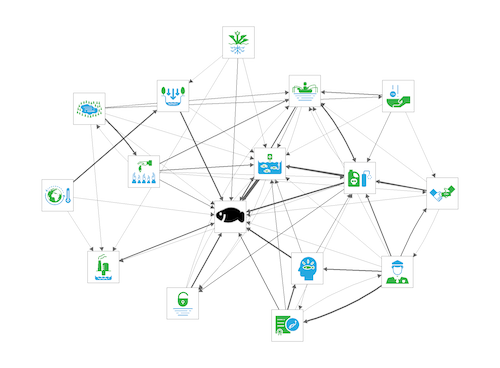
The aggregate mental model of Tanzanian fishers of the drivers of the Nile perch stock. The image shows how fishers’ mental models focus on fishing in breeding grounds, the use of destructive gear and overfishing.
Next, we explore stakeholders’ mental models of a socio-ecological system and assess content and complexity differences across experience levels, migration status, and regions (van den Broek et al., under review). We mapped the mental model of drivers of the Nile perch fish stock fluctuation at Lake Victoria for 185 Tanzanian fishers. The findings show that (1) fishers’ mental models were complex and diverse, (2) mental models tended to focus on the use of destructive fishing activities, (3) mental model complexity, but not content, varied across regions and (4) fishing experience and migration status were not consistently related to mental model complexity or content. In particular, we found that fishers converge in their perception that fishers’ activities, especially non-compliance with regulations, contributes to stock decline in a major way. These results have important implications for environmental resource management at Lake Victoria.
Researchers: Dr. Karlijn van den Broek, Dr. Helen Fisher, Dr. Sina Klein
Partners: Dr. Jan van den Broek, Joseph Luomba (TAFIRI), Horace O. Onyango (KMFRI), Bwambale Mbiling (NaFIRRI), Joyce Akumu (NaFIRRI)
Publications:
Klein, S. A., van den Broek, K. L., Luomba, J., Onyango, H. O., Mbilingi, B., & Akumu, J. (2021). How knowledge acquisition shapes system understanding in small-scale fisheries. Current Research in Ecological and Social Psychology, 2, 100018.
van den Broek, K. L. (2018). Illuminating divergence in perceptions in natural resource management: A case for the investigation of the heterogeneity in mental models. Journal of Dynamic Decision Making, 4, 1–5. https://doi.org/10.11588/jddm.2018.1.51316
van den Broek, K. L., Luomba, J., van den Broek, J., & Klein, S. (Under review). Fishers’ mental models reveal their perceived role in conserving fish stock and regional differences.
Risk-taking Behaviour Among Fishers: Social Information and Luck
Risk is an essential component of fisheries decisions, especially in a complex, potentially tipping environmental system such as Lake Victoria. Fishers make many risky decisions, e.g. how much to invest in equipment and whether to comply with regulations. In this environment, they constantly receive feedback on past decisions and also observe the decisions of other fishers. The socio-ecological system of Lake Victoria adds an important dimension of risk and uncertainty because fishers livelihoods can be threatened if the ecosystem passed a tipping point. Therefore, understanding fishers risk-taking behaviour is important when considering policies for common pool resource management.
To understand how experiencing luck and social information influence fishers risk decisions, MultiTip conducted a lab-in-the-field experiment in Tanzanian at Lake Victoria (Dannenberg et al. 2022). In the experiment, fishers made a risky investment decision under controlled conditions. The experiences of good or bad luck and information about the behaviour of other fishers differed between experimental conditions. The results show that while the experience of good or bad luck does not significantly affect decision making, there are positive feedback effects between fishers. When fishers learn that other fishers engage in risky behaviour, they take more risk than fishers who get no information. However, the feedback effect is asymmetric. When fishers learn that other fishers engage in low-risk behaviour, their risk taking does not differ from fishers who get no information.
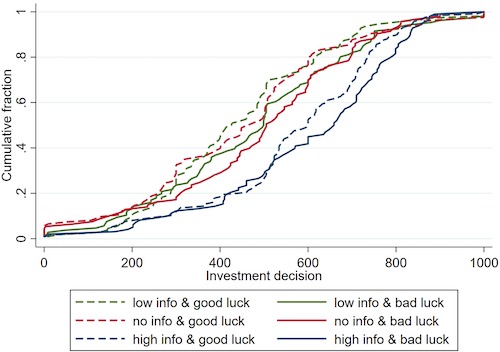
The cumulative distribution of fishers’ individual investment decisions by experience of good or bad luck and social information (no information, low information or hight information).
Note: The cumulative distribution in this graph shows the fraction of participants within the same treatment condition who invest the respective amount or less. Participants with high and low stakes in the betting task are pooled.
To read about the policy insights and implications of these findings click here.
Researchers: Prof. Dr. Astrid Dannenberg, Prof Dr. Florian Diekert, Philipp Händel (Ph.D. Candidate)
Partner: Joseph Luomba (TAFIRI)
Publication: Dannenberg, A., Diekert, F. & Händel, P. (2022) The Effects of Social Information and Luck on Risk Behavior of Small-Scale Fishers at Lake Victoria, Journal of Economic Psychology,90,102493. https://doi.org/10.1016/j.joep.2022.102493
Top of page
Risk-taking Behaviour Among Fishers: Cooperation
We also examined how interactions between fishers affect risk-taking behaviour and cooperation by conducting two lab-in-the-field experiments with Ugandan fishers at Lake Victoria. In our first experiment, we examine how individual risk decisions are altered by various potential effects on another individual. Through our unique design, we are able to show whether fishers change their decisions depending on how a risky decision affects the income of another individual. We also examine which risky decisions are sanctioned by the individuals involved.
In our second experiment, fishers played a resource extraction game. In this experiment, we examine how fish scarcity changes their willingness to engage in cooperative resource management and whether fishers behave more or less cooperatively when they know that another fisher will join them later (through migrating), making him or her dependent on their prior decisions.
With the different parts of the study, we can assess how the impact of one's behaviour on others, as well as changes in environmental conditions and social structures, affect the behaviour of fishers. This will lead to a better understanding of the behavior of fishers, and the influence of their perception of the socio-ecological environment on that behavior. The results of this study will be important for understanding how best to communicate the socio-ecological situation to fishers, how to develop effective management structures and how to predict future trends in the fishery. The data analysis for this study is ongoing.
To read about the policy insights and implications of these findings click here.
Researchers:Philipp Händel (Ph.D. Candidate), Sophia Charlotte Klatt (Ph.D. Candidate), Pia Pico (Ph.D. Candidate), Prof. Dr. Astrid Dannenberg
Partner: Dorothy Birungi (NaFIRRI)
Demand for Complete and Incomplete Punishment Institutions to Promote Coorperation
There is an ongoing debate on Lake Victoria about how best to enforce fishing regulations. This is further complicated by the fact that the resource is divided between three riparian states that currently have different enforcement systems. Enforcement of rules and regulations at Lake Victoria are mostly centralised and a frequently cited reason for this is the weak enforcement of illegal fishing activities by local institutions. Fishers, however, still prefer local enforcement by their own people to enforcement by the government (Mpomwenda et al. 2022). A incomplete punishment institution is one in a decentralised setting where punishment only affects a subgroup of all relevant actors and a complete punishment institutions is in a central setting where punishment affects all relevant actors. We conducted an online experiment with German students to understand the general mechanisms that drive demand for incomplete and complete punishment institutions.
Participants played a public goods game (6 persons) with a punishment option. Our study examines the general willingness to vote for the severity of a punishment institution that automatically punishes non-cooperative behavior of either all or a subset of players. We compare the demand for a complete punishment institution that affects all players equally with the demand for an incomplete punishment institution that affects only a subset consisting of half of the players. Since imposing a severe punishment makes it rational to contribute everything to the public good, standard economic theory predicts that rational participants would vote for a severe punishment institution if they benefit from the cooperation of the bound group. Otherwise, they would vote against punishment. To test this prediction for complete and incomplete punishment institutions, we varied the marginal group return (MGR) of the public good in different experimental treatments.
Our experiment shows that with complete punishment institution, the demand for a strict punishment is based on the benefit of cooperation that will result from this punishment. With incomplete punishment institutions, however, we can see that the benefit of cooperation through strict punishment plays a less important role. Here individuals’ cooperativeness and the behavior of non-bound actors are important determinants of the demand for a strict punishment. This leads to more cooperation than predicted when benefits are low, but less cooperation than predicted when benefits are high. Our results also suggest that in a decentral setting, support for strict enforcement highly depends on whether neighboring users are able and willing to implement similar institutions.
Histogram of frequency of chosen punishment rates (severity) in different treatments divided on whether cooperation of bound group is beneficial or not and on whether the punishment institution is complete or incomplete. The treatments describe who is able to vote (one small group (3vote), both small groups (3+3vote) or all participants (6vote)) and the marginal group return of the public good for all 6 players (0.75, 1.5, 2.5).
To read about the policy insights and implications of these findings click here.
Researchers: Dr. Christoph Bühren, Prof. Dr. Astrid Dannenberg, Phillipp Händel (Ph.D. Candidate)
References:
Andersen, K. H. (2019). Fish Ecology, Evolution, and Exploitation: A New Theoretical Synthesis, volume 93. Princeton University Press.
Blanchard, JL, Andersen, KH, Scott, F, Hintzen, NT, Piet, G, and Jennings, S (2014). Evaluating targets and trade-offs among fisheries and conservation objectives using a multi-species size spectrum model. Journal of Applied Ecology, 51(3):612-622.
Bostrom, A. (2017). Mental Models and Risk Perceptions Related to Climate Change. Oxford Research Encyclopedia of Climate Science, 1–31. https://doi.org/10.1093/acrefore/9780190228620.013.303
Diekert, FK, Hjermann, D. Ø., Nævdal, E., and Stenseth, NC (2010). Spare the young fish: optimal harvesting policies for north-east arctic cod. Environmental and Resource Economics, 47(4):455-475.
Diekert, F., T. Goeschl, C. König-Kersting (2021): Social Risk Effects: The 'Experience of Social Risk' Factor. AWI Discussion Paper 701, Heidelberg University
Edwards, AM, Robinson, JP, Plank, MJ, Baum, JK, and Blanchard, JL (2017). Testing and recommending methods for fitting size spectra to data. Methods in Ecology and Evolution, 8(1):57-67.
Findlater, K. M., Donner, S. D., Satterfield, T., and Kandlikar, M. (2018). Integration anxiety: The cognitive isolation of climate change. Glob. Environ. Chang. 50, 178–189. doi: 10.1016/j.gloenvcha.2018.02.010
Folke, C. (2006). Resilience: The emergence of a perspective for social-ecological systems analyses. Global Environmental Change, 16(3), 253-267. https://doi.org/10.1016/j.gloenvcha.2006.04.002
Forrester, J. W. (1992). Policies, decisions and information sources for modeling. European Journal of Operational Research, 59(1), 42–63.
Goldberg, M. H., Gustafson, A., & van der Linden, S. (2020). Leveraging social science to generate lasting engagement with climate change solutions. One Earth, 3(3), 314–324. https://doi.org/10.1016/j.oneear.2020.08.011
Gómez-Cardona, S., Kammerer, J., and Mrosso, H. (2022). Fishing fleet selectivity in lake victoria’s nile perch fishery. AWI discussion paper series, dp712.
Gray, S. R. J., Gagnon, A. S., Gray, S. A., O'Dwyer, B., O'Mahony, C., Muir, D., Devoy, R. J. N., Falaleeva, M., & Gault, J. (2014). Are coastal managers detecting the problem? Assessing stakeholder perception of climate vulnerability using Fuzzy Cognitive Mapping. Ocean and Coastal Management, 94, 74–89. https://doi.org/10.1016/j.ocecoaman.2013
Kolding, J., Medard, M., Mkumbo, O., and van Zwieten, P. (2014). Status, trends and management of the Lake Victoria Fisheries. Inland Fisheries Evolution and Management—Case Studies from Four Continents. FAO Fisheries and Aquaculture Technical Paper, 579.
LaMere, K., Mäntyniemi, S., Vanhatalo, J., & Haapasaari, P. (2020). Making the most of mental models: Advancing the methodology for mental model elicitation and documentation with expert stakeholders. Environmental Modelling and Software, 124(104589). https://doi.org/10.1016/j.envsoft.2019.104589
Levy, M. A., Lubell, M. N., and Mcroberts, N. (2018). The structure of mental models of sustainable agriculture. Nat. Sustain. 1, 413–420. doi: 10.1038/ s41893-018-0116-y
Martin, R., & Schlueter, M. (2015). Combining system dynamics and agent-based modeling to analyze social-ecological interactions—an example from modeling restoration of a shallow lake. Frontiers in Environmental Science, 3(October), 1-15. https://doi.org/10.3389/fenvs.2015.00066
Miles, PR (2019). pymcmcstat: A python package for bayesian inference using delayed rejection adaptive metropolis. Journal of Open Source Software, 4(38):1417.
Peter, HK and van Zwieten, PA (2018). Operational, environmental, and resource productivity factors driving spatial distribution of gillnet and longline fishers targeting nile-perch (lates niloticus), lake victoria. Journal of Great Lakes Research, 44(6):1235-1251.
Rouwette, E. A. J. A. (2016). The impact of group model building on behaviour. In Behavioral Operational Research: Theory, Methodology and Practice, Kunc M, Malpass J, White L (eds). Palgrave MacMillan, London; 213–241.
van den Broek, K. L. (2018). Illuminating divergence in perceptions in natural resource management: A case for the investigation of the heterogeneity in mental models. Journal of Dynamic Decision Making, 4, 1–5. https://doi.org/10.11588/jddm.2018.1.51316
Varela, B., Sesto, V., and García-Rodeja, I. (2020). An investigation of secondary students’ mental models of climate change and the greenhouse effect. Res. Sci. Educ. 50, 599–624. doi: 10.1007/s11165-018-9703-1
Wood, M. D., Thorne, S., Kovacs, D., Butte, G., & Linkov, I. (2017). Mental Modeling Approach. Springer New York. https://doi.org/10.1007/978-1-4939-6616-5
Webpage Editor:
E-Mail
Updated on:
13.10.2023


